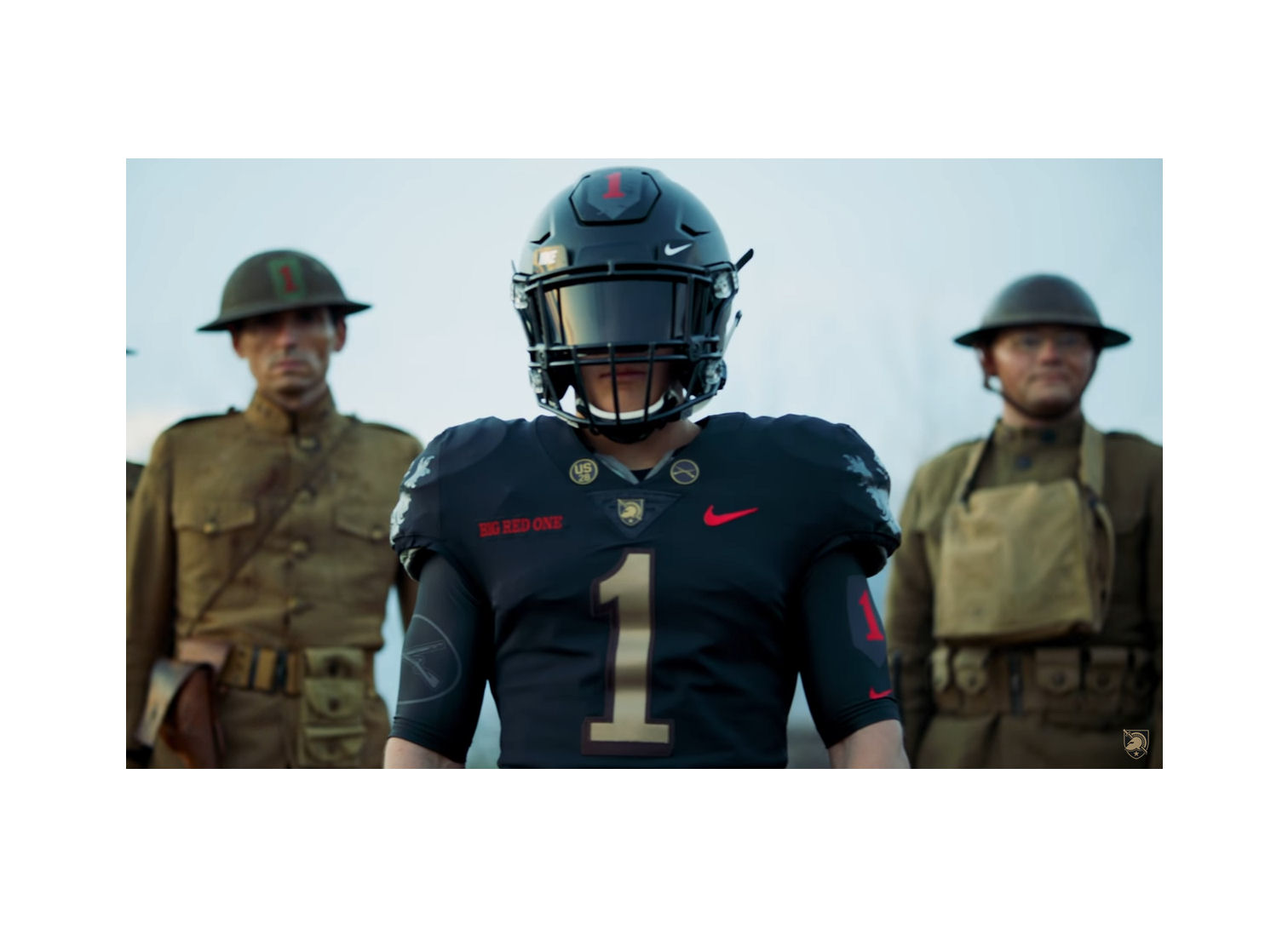When Army takes the field Saturday to face Navy in one of the great rivalry games in all of college football, the Black Knights’ black uniforms will pay tribute to Fort Riley’s First Infantry Division.
One hundred years ago the Fort Riley based 1st Infantry Division known as the “Big Red One” led the Allies to victory in World War I. This year, the Army West Point Athletics football team honors the “Big Red One” with custom Nike jerseys for the Army Navy Game.
2018 marks the 100th Anniversary of America’s First Division helping end the first great war of the 20th Century, World War I. The First Infantry Division has many distinctions that include:
- The FIRST permanent division in the regular Army.
- The FIRST American division to fight in the first World War.
- The FIRST to use modern, combined arms operations.
- The FIRST to defeat the enemy at the Battle of Cantigny.
The “First” Division
President Woodrow Wilson promised the Allies he would send “a division” to France immediately, but the Army had no such divisions. The United States quickly ordered four infantry and three artillery regiments from the Mexican border in Texas to Hoboken, N.J., to board transports to France. That group of seven regiments joined together to officially form the “1st Expeditionary Division,” later the 1st Infantry Division, under Brigadier General William L. Sibert on June 12, 1917. With more than 28,000 men, the “Big Red One,” as the division was later nicknamed from its shoulder sleeve insignia, was twice the size of either the allied or German divisions on the Western Front.
Black Lions of Cantigny
The 1st Division’s 28th Infantry won the first major American victory in World War I at the Battle of Cantigny, a small village north of Paris held by the German Army. Along with the rest of the 1st Division and French Troops, they successfully attacked and defeated the German forces in just 45 minutes, holding the village against repeated counterattacks. Their success raised the Allies’ morale and disproved German propaganda about American combat incapacity.
General of the Armies: John “Black Jack” Pershing
A 1886 graduate of West Point, John J. Pershing had been the First Captain as a cadet. As a First Lieutenant he commanded a cavalry troop in the 10th Cavalry Regiment, a Buffalo Soldier unit, earning the nickname “Black Jack.” Prior to World War I he had seen service in a number of campaigns and wars, including the Spanish-American War, Philippine War, and the Pancho Villa Expedition in Mexico. Selected to command the American Expeditionary Forces (AEF), the American contribution to Allied operations during World War I, Pershing became the first full (four-star) general in the U.S. Army since Philip Sheridan. Charged with organizing, training, and supplying the over two million Americans who would serve in the AEF, Pershing would eventually be honored with a promotion to General of the Armies, a six-star rank equivalent, the only American to be so-privileged in his lifetime.
George Marshall
George C. Marshall, a 1901 graduate of the Virginia Military Institute, served as the 1st Division’s Operations Officer before and during the Battle of Cantigny, earning widespread acclaim for his planning of the successful American attack during the battle. Later serving on General Pershing’s staff, Marshall would go on to become the Chief of Staff of the U.S. Army during World War II as a five-star General of the Army. During World War II, he is reputed to have said, “I want an officer for a secret and dangerous mission. I want a West Point football player.” These words are immortalized on a bronze plaque at Michie Stadium, a plaque which all Army football players touch before they take the field for home games.
Rags, The Official Unit Mascot
A stray mixed-breed terrier, Rags, was befriended and given his name by then-Private Jimmy Donovan in Paris in July of 1918. More than just the 1st Divison’s mascot through World War I and afterwards, Rags served as a messenger and helped Donovan, a Signal Corps soldier, find broken telephone lines in need of repair. On some occasions, Rags even alerted 1st Division soldiers to incoming artillery fire, and both he and Donovan suffered injury from German artillery and gas shells during the Meuse-Argonne Offensive. Rags remained a celebrity after World War I, being featured in several New York Times articles and receiving a number of awards before passing away in 1936.
International Relations
Although American forces had been working with troops from other nations since the alliance with the French in the American Revolution, World War I arguably saw the first large-scale contribution of troops to work with the forces of foreign nations in a coalition. AEF units were commonly armed with French machine guns and field artillery, and during the Battle of Cantigny, American infantry benefited from the support of French tanks and French artillery.



